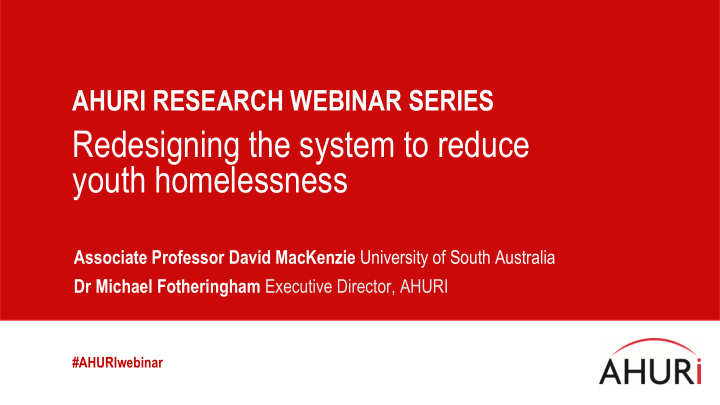



AHURI RESEARCH WEBINAR SERIES Redesigning the system to reduce youth homelessness Associate Professor David MacKenzie University of South Australia Dr Michael Fotheringham Executive Director, AHURI #AHURIwebinar
AHURI RESEARCH WEBINAR SERIES Welcome Dr Michael Fotheringham Executive Director, AHURI #AHURIwebinar
COVID-19 RESOURCE HUB Visit: ahuri.edu.au/covid-19 Contact us at: information@ahuri.edu.au #AHURIwebinar
HOUSEKEEPING Webinar recording available at: ahuri.edu.au/events/ahuri-webinar-series-1 Complete our survey: to be sent following today’s webinar #AHURIwebinar
WEBINAR FEATURES Change audio settings Submit questions for presenter #AHURIwebinar
TODAY’S WEBINAR Presenter: Associate Professor David MacKenzie University of South Australia Research: Redesign of a homelessness service system for young people Download the report: ahuri.edu.au/research/final-reports/327 #AHURIwebinar
PRESENTATION Redesign of a homelessness service system for young people David MacKenzie, University of South Australia AHURI Research Webinar Series Wed 29 April 2020
PART 1: The Research AHURI Research Webinar Series Wed 29 April 2020
WHAT DO WE MEAN BY ‘A SYSTEM’? ‘System Thinking’ ▸ Young people are at the centre of ‘the system’; ▸ The parts of the system interact; ▸ Interacting parts are interventions, programs and institutions that affect young people; ▸ A system centred around young people is local and community-based; ▸ The ‘community as system’ is open not closed and influenced by policies and funding. AHURI Webinar
THIS IS ONE WAY TO REPRESENT THE DYNAMICS OF A SYSTEM A ‘stock’ & ‘flow’ diagram of the youth homelessness system AHURI Webinar
THIS IS ANOTHER WAY TO REPRESENT THE DYNAMICS OF A SYSTEM A causal loop diagram of the youth homelessness system AHURI Webinar
REDESIGN OF A HOMELESSNESS SERVICE SYSTEM FOR YOUNG PEOPLE How the research was done! ➢ The ‘system’ as a place -based community of interventions, Q1. How can rebalancing the support system for vulnerable programs and institutions that affect young people, and are, in young people be rebalanced to significantly expand early turn, affected by young people — an ecosystem around young intervention and post- homelessness rapid rehousing and people that extends beyond the SHS. supported housing for young people? ➢ The most promising initiatives for system change are most likely Q2. What changes to housing agreements and policies, as well to be found in some form somewhere among the many programs as income and employment support policies and practices, and services across Australia. would be needed to redress the current issues young people have in accessing and maintaining affordable housing ➢ Using purposive sampling, key informants were sought in options? community settings known for promising initiatives or innovation. Q3. How can the education/employment support systems and ➢ Redesigning the homelessness system is about finding reforms the community services/homelessness systems be better and measures that promise to lead to better outcomes, especially integrated systemically to reduce the cohort of disadvantaged where there is a strong evidence-base. and/or homeless individuals into the future and across the life course? ➢ System redesign initiatives and reforms are not just about changes to the SHS. AHURI Webinar
PART 2: Findings AHURI Research Webinar Series Wed 29 April 2020
YOUNG PEOPLE ARE A SIGNIFICANT CLIENT GROUP EXPERIENCING HOMELES SNESS’? Homeless Young People ▸ About 44% of all individuals SPECIALIST�HOMELESSNESS�SERVICES� CLIENTS:��15-24�YEARS who seek help from the SHS 50,000 are young people and children; 40,000 ▸ About 81,000 are children, young people and young parents in family groups; 30,000 ▸ About 16% or 42,000 SHS clients are young people 15-24 20,000 years of age on their own.
CAUSES OF YOUTH HOMELESSNESS Youth Homeless continues … ▸ Family conflict and domestic violence have not decreased; ▸ More young people referred to care and protection services; ▸ Housing affordability has not improved; ▸ Youth incomes and benefits are too low. The front cover image of HREOC Report ‘Our Homeless Children’ (1989) AHURI Webinar
CAUSES OF HOMELESSNESS REMAIN ISSUES Leaving Care … ▸ Young people leaving out- of-home care (OOHC) into independent living arrangements are particularly vulnerable to experiencing homelessness. AHURI Webinar
THE CYCLE OF HOMELESSNESS Leaving SHS services … ▸ Between 40 to 50% of young people exiting homelessness services move into a further situation of homelessness AHURI Webinar
THE CYCLE OF HOMELESSNESS Engagement in Education or Training… ▸ Engagement in education and training — as well as supported pathways towards employment — was raised as a crucial factor in the future options that homeless young people may or may not have. AHURI Webinar
THE CYCLE OF HOMELESSNESS Housing options for youth… ▸ Access to social housing remains highly problematic (2.9% of main tenants); ▸ Youth-specific and youth- appropriate housing is an under-developed policy concept; ▸ Private rental housing is problem due to low incomes. AHURI Webinar
THE CYCLE OF HOMELESSNESS “we need more crisis accommodation” ▸ Understandable from lived experience dealing with one crisis case after another; ▸ Feels intuitively right at the coal- face … but; To reduce the road toll, we don’t install more trauma beds in the hospital – we implement airbags, seat ▸ Is this a policy informed by belts, speed cameras and safer cars and improve road system thinking that can conditions to reduce the number of accidents end homelessness? AHURI Webinar
INDIGENOUS HOMELESSNESS IN AUSTRALIA Aboriginal young people ▸ Over-represented in Specialist Homelessness Services; ▸ ‘Culturally -appropriate service provision and practice’; ▸ Choice of indigenous or non-Indigenous support options? AHURI Webinar
PART 3: Policy Options AHURI Research Webinar Series Wed 29 April 2020
Policy options for reducing youth homelessness AHURI Webinar
The COSS Model [aka The Geelong Project] AHURI Webinar
Policy options for reducing youth homelessness AHURI Webinar
What the redesign needs to do! AHURI Webinar
Paradigm Shift – a redesigned system Place-based service delivery Siloed service delivery ‘collective impact’ ‘targeted programs’ AHURI Webinar
Individuals and organisations interested in further discussions about system change should contact: Email: david.mackenzie@upstreamaustralia.org.au
Audience Q&A Submit questions for presenter AHURI Research Webinar Series Wed 29 April 2020
OUR NEXT WEBINAR… Registrations open tomorrow – Thu 30 Apr Visit: ahuri.edu.au/events #AHURIwebinar
AHURI RESEARCH WEBINAR SERIES Thank you for attending AHURI Research Webinar Series Wed 29 April 2020

Recommend
More recommend